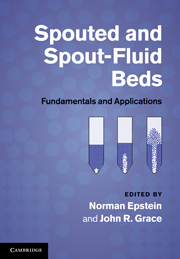Book contents
- Frontmatter
- Contents
- Contributors
- Preface
- Common nomenclature
- 1 Introduction
- 2 Initiation of spouting
- 3 Empirical and analytical hydrodynamics
- 4 Computational fluid dynamic modeling of spouted beds
- 5 Conical spouted beds
- 6 Hydrodynamics of spout-fluid beds
- 7 Spouted and spout-fluid beds with draft tubes
- 8 Particle mixing and segregation
- 9 Heat and mass transfer
- 10 Powder–particle spouted beds
- 11 Drying of particulate solids
- 12 Drying of solutions, slurries, and pastes
- 13 Granulation and particle coating
- 14 The Wurster coater
- 15 Gasification, pyrolysis, and combustion
- 16 Spouted bed electrochemical reactors
- 17 Scaleup, slot-rectangular, and multiple spouting
- 18 Mechanical spouting
- 19 Catalytic reactors and their modeling
- 20 Liquid and liquid–gas spouting of solids
- Index
- References
19 - Catalytic reactors and their modeling
Published online by Cambridge University Press: 04 February 2011
- Frontmatter
- Contents
- Contributors
- Preface
- Common nomenclature
- 1 Introduction
- 2 Initiation of spouting
- 3 Empirical and analytical hydrodynamics
- 4 Computational fluid dynamic modeling of spouted beds
- 5 Conical spouted beds
- 6 Hydrodynamics of spout-fluid beds
- 7 Spouted and spout-fluid beds with draft tubes
- 8 Particle mixing and segregation
- 9 Heat and mass transfer
- 10 Powder–particle spouted beds
- 11 Drying of particulate solids
- 12 Drying of solutions, slurries, and pastes
- 13 Granulation and particle coating
- 14 The Wurster coater
- 15 Gasification, pyrolysis, and combustion
- 16 Spouted bed electrochemical reactors
- 17 Scaleup, slot-rectangular, and multiple spouting
- 18 Mechanical spouting
- 19 Catalytic reactors and their modeling
- 20 Liquid and liquid–gas spouting of solids
- Index
- References
Summary
In an earlier review on modeling of catalytic gas–solid fluidized bed reactors, spouted beds were treated as a special case of fluidized beds, with the jet region extending to the upper free surface of the solids emulsion. The spout and the annulus are two well-distinguished zones, characterized by such different gas–solid contacting that they have been treated distinctly since the first approach for modeling spouted bed chemical reactors. The spout zone acts as a dilute vertical transport system, whereas the peripheral annulus has many similarities with a countercurrent downflow packed bed, the major peculiarity being gas percolation into the dense emulsion from the spout. Therefore, solids motion in a spouted bed is a major factor affecting mass and heat transfer, mixing, contacting, and hence the choice of reactor model. The solids can react (e.g., in combustion, where they are depleted over time), constitute inerts (e.g., sand diluting a solid fuel and regulating the system hydrodynamics, as well as providing a heat buffer), or act as a catalyst.
Successful design and operation of a reactor depend on the ability to predict the system behavior, especially the hydrodynamics, mixing of individual phases, heat and mass transfer rates, and kinetics of the reactions involved.
- Type
- Chapter
- Information
- Spouted and Spout-Fluid BedsFundamentals and Applications, pp. 305 - 320Publisher: Cambridge University PressPrint publication year: 2010

